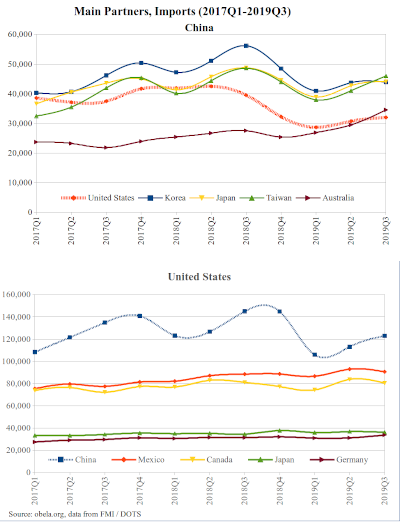The course of the trade war that the United States has been waging against China since January 2018 has changed again. Initially, in order to correct a huge trade deficit of more than $793 billion by 2017 (equivalent to the GDP of Belgium and Portugal combined), Trump launched a tariff war against the most dynamic export economy since 2009: China. The objective was not only to reduce the trade deficit with this economy, but to weaken its economic growth dynamics, 6.7%, and to reduce its growing share in the export market, 13% of total exports, by 2017. However, the result has not favoured the US and has been adverse to the multilateral international order.
When the war began, the US deficit with China was equivalent to 47% of its trade balance. The main US imports came from: China, Mexico, Canada and Japan, in that order. In contrast, China's surplus with the US, by 2017, represented about 62% of the total; and its main purchases came from Korea, the US, Japan and Taiwan. Although the two economies were major supplying partners for imports, the content of these imports was different. While China was buying transport vehicles (cargo and air), machinery and grains; the US was importing computer equipment and machinery, manufactures and semi-finished products.
After 23 months of war, 7 rounds of mutual tariff aggression, more than 15,000 products taxed, $600 billion in tariffs and two periods of truce (more information), the two economies entered into a first agreement. Two days before the entry into force of the tariffs published in August 2019 (10% on 556 Chinese products, and 10% and 5% on 3,361 US products), the start of negotiations was announced on 13 December 2019 (read more). On a seasonal basis, similar to the December 2018 truce, it was agreed not to implement new tariff measures, although none of those imposed were reduced.
The central objective of the imposition of tariffs is to restrict imports from the country to which it applies. China, on the one hand, reduced the share of US imports to the point that it displaced the US from second place, as the main importing partner, to fifth place. On the other hand, the United States could not achieve the same thing. Its imports from China remained stable, and it is still the main importing partner of the USA. (See graphic).

With the trade war, the US did reduce its deficit with China by -7%, but from a contraction in its exports by -17%, and in its imports by -10%. With this, it reinforced its inability to promote economic growth, which continued to decline from 2.9 to 2.3% between 2018 and 2019. China, for its part, continues to have a surplus balance with the United States, participates in more than 13% of world exports and will still grow by more than 6% in 2019.
On January 15, the signing of the First Phase of an "Economic and Commercial Agreement between the United States of America and the People's Republic of China" was announced. The unbalanced diplomatic representation, between President Donald Trump and Vice Prime Minister Liu He, for the signing of the agreement, was presented as an American victory, which imposed new conditions on China. This agreement defined new conditions on: intellectual property; technology transfer; agriculture; financial services; monetary policy; trade expansion; and trade dispute resolution. The evidence shows that the US is losing the war, without meaning that China is winning it.
Very specifically, through this agreement the US seeks that China "end its practice of pressuring foreign companies to transfer its technology"; that it "remove trade and investment barriers for US financial service providers"; that it "not use monetary practices to compete unfairly with US exporters"; and most importantly, that it import "US goods and services over the next two years in an amount of no less than $200 billion". Again, the agreement does not imply the withdrawal of tariffs imposed since 2018, but only stops the new impositions.
On February 6, China announced some measures that are in line with both the first phase agreements and the recent health crisis caused by the coronavirus outbreak. Cuts were announced at tariffs of 10 to 5%, and 5 to 2.5% in imports from the United States, which correspond to the tariffs applied at the beginning of September 2019, on 1,717 products. It should be noted that this list was focused on 39% live animals and animal products, and 24% products from the chemical industry. This measure implemented by China is more focused on solving the meat shortage caused by the swine fever in the second quarter of 2019 and the growing need for medicines; rather than by U.S. commercial demands.
Additionally, the Agreement included a chapter on Dispute Resolution. This mechanism ignores the multilateral structure of the World Trade Organization (WTO) and is bilateral. With this agreement and the new North American Free Trade Agreement, the United States advances in the construction of a new international commercial order on the law of the strongest. The best example is the modification of the WTO list of developing and least developed countries, which enjoyed trade preferences, which was changed on 10 February last, when countries were unilaterally eliminated.









